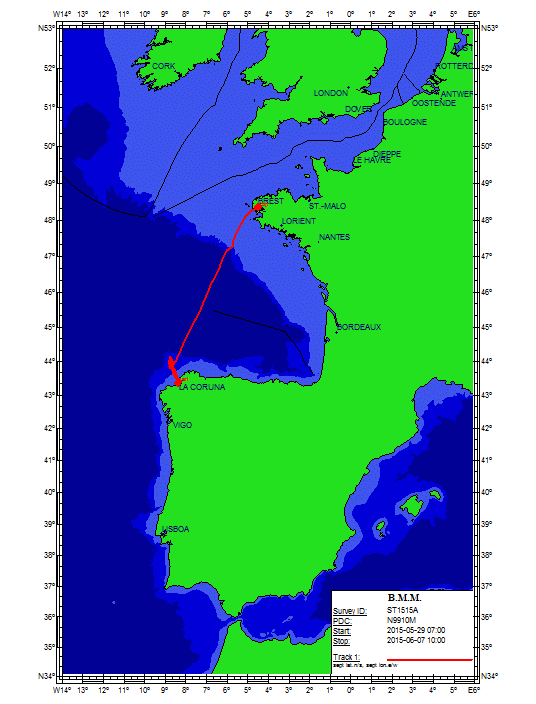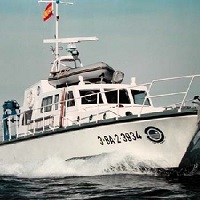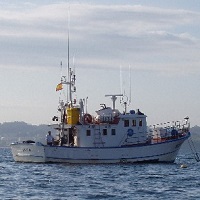Creation year
2015
225 record(s)
Type of resources
Categories
Topics
INSPIRE themes
Keywords
Contact for the resource
Provided by
Years
Formats
Status
-
Acoustic measurements.
-
The series of PELMED cruises began in 1993. Their objective is to assess small pelagic resources in the Gulf of Lion, using the echo-integration method and trawling to identify the detections observed. Until 2007, each cruise consisted in systematically prospecting from Port-Vendres to Marseille, along 9 legs set 12 nautical miles apart, perpendicular to the coast, in daytime (6 am to 9 pm), along the entire width of the continental shelf. Acquisition along legs for acoustic prospection covered 440 nautical miles and the catches from trawling to identify the structures encountered led to a complete analysis: number and weight by species, size sampling, otolith samples taken in order to construct size-age keys for sardines, anchovies and hake, updating of biological parameters.
-

FWO MINIMOUND Project: Using Cold-water coral mini-mounds as analogue for giant mound growth: assessment of environmental drivers and anthropogenic impact Cold-water corals (CWC) are found along the entire north-eastern Atlantic Margin from Norway to the Gulf of Cadiz. In the Porcupine Seabight, these coral reefs (mainly Lophelia pertusa and Madrepora oculata) accumulate into large mounds of up to 250m high (e.g. Challenger Mound), which have been well studied over the past two decades (Roberts et al., 2006). The detailed mechanism of the start-up phase of such large CWC mounds is however not yet fully understood. Therefore, it is essential to study analogues of these stages that are not well recorded in larger mounds. The FWO MINIMOUND project (2013-2016) aims to investigate the initiation, growth and demise of small CWC mounds and to determine the role of climatic and hydrocarbon-seepage related processes as well as anthropogenic impact. This high-resolution multidisciplinary study will focus on three minimound provinces along the Biscay continental margin: (1) the Explorer and Dangeard Canyons on the Celtic Margin (Fig. 1; Stewart et al., 2013), (2) the Guilvinec Canyon on the Armorican Margin (De Mol et al., 2011) and (3) the Upper Ferrol Canyon on the Cantabrian Margin (Fig. 1). These minimounds are fossil (9.7 ka BP) and occur at relative shallow depth on the interface between the Eastern North Atlantic Central Water (ENACW) and the Mediterranean Outflow Water (MOW). Contrastingly, most present-day living CWC reef habitats dwell in the deeper MOW depth range, relying on the density and dynamics of this water mass for their food supply.   The objectives of the project are threefold: (1) the establishment of a chronostratigraphic framework and the reconstruction of palaeoceanographic changes over the last 15.000 years in order to determine the impact of glacial to interglacial climate change on the ENACW-MOW interface and the CWC habitats (Frank et al., 2011); (2) the minimound province at the Upper Ferrol Canyon shows a close association with hydrocarbon-seepage (pockmarks) which allows to assess the role of hydrocarbon related processes in CWC mound formation; (3) the potential impact of anthropogenic fisheries activities will be investigated. These objectives will be tackled through a coupled geophysical, sedimentological and integrative approach, including the palaeoceanographic and biogeochemical study of sediment cores in cooperation with the BGS (UK), LSCE (Gif-sur-Yvette, France), IFREMER (France), IGME (Spain) and IEO (Spain). This Belgica2015/15 cruise is the second campaign of the project and it aims to sample both on-mound as off-mound sites by means of a 4.5 m vibrocorer (Supplied by the British Geological Survey, BGS). The target site are located on the upper slopes of the Ferrol Canyon (Cantabrian margin, Spanish EEZ) and the Guilvinec Canyon (Armorican margin, French EEZ) between 200 and 600 m water depth. In each sector, a minimum of 3 days of activities will be scheduled. In case of bad weather on 1 sector, the program will be revised towards the other sector. With respect to the size of these mounds, the coring location of the vibrocorer will be steered by means of am IXSEA USBL GAPS system. During night-time, the seafloor will be visually characterized using a small and light-weight camera dropframe (University of Plymouth).
-
<p style="text-align:justify">The main scientific objectives of the cruises are threefold:</p> <ul> <li style="text-align: justify;">to asses the large scale circulation in the Western Basin, evaluating the water masses and the fluxes at different key point in the basin (The North Current, The East and West Corsica currents, the Balearic front, Algerian Basin). The final goal was numerical modelling assessment.</li> <li style="text-align: justify;">to identify and follow peculiar mesoscale structures such as surface eddies, modal weddies, submesoscale coherent vortices (SCV) meanders or filaments and explore the signature on the sea surface height (altimetry) and the acoustic impact (sound propagation).</li> <li style="text-align: justify;">to observe and interpret the submesoscale dynamics such ageostrophic stirring, symmetric instabilities, mixed layer instabilities, subduction and convection.</li> </ul> <p style="text-align:justify">The <strong>Protevs2015_leg1 </strong>campaign took place from the 8th to 28th of January 2015 on board of the RV <em>Pourquoi Pas?</em> in the north western mediterranean basin. It is focused on physical aspects (hydrology and dynamics). The main objective was the dynamics of the North current from its roots in the Ligurian Sea downstream to the Gulf of Lion. The surveys try to catch not only the meso-scale features but also the submesoscale associated to the the northern current or at least in its vicinity.</p> <p style="text-align:justify"> </p> <p style="text-align:justify"> </p>
-
The objective of cruise DY039 was to service the moorings of the RAPID 26°N project that are deployed to monitor the Atlantic Meridional Overturning Circulation. For each mooring instruments were recovered, data were downloaded and instruments were redeployed. A number of CTDs were made to calibrate the instruments from the moorings. In addition to the standard instruments used in previous years on the RAPID array, biogeochemical instruments were deployed for the ABC Fluxes project, along with some additional temperature sensors and ADCPs for the MerMeed project. During passage from Southampton to Tenerife trial CTDs were completed in international waters. After a short port call in Santa Cruz de Tenerife, departing on the 26th October work commenced on the eastern boundary sub-array comprising of moorings EBH4, EBH4L, EBH3, EBH2, EBH1, EBH1L, EBHi, EB1 and EB1L. A lander was deployed alongside EBHi to provide delayed-mode data telemetry through timed data pod release. Work on the MAR sub-array commenced on 7th November at mooring MAR3. The other moorings in this sub-array (MAR3L, MAR1, MAR1L, MAR2 and MAR0) were all completed by 12th November. The NOG mooring was also recovered and redeployed as part of the MAR sub-array servicing. Mooring WB6 was serviced on 19th November before transiting to Nassau for customs clearance. The remaining western boundary sub-array moorings (WBADCP, WBAL, WB1, WB2, WB2L, WBH2, WB4 and WB4L) were serviced between the 22nd November and the 30th November before docking in Nassau on the 1st December.
-
Our project aims at assessing the different biogeochemical processes controlling the nitrogen cycle in oligotrophic N.E. Atlantic waters. Our approach is based on the use of dual nitrate isotope measurements (natural abundance and enrichment experiments) to disentangle these various N processes in the marine environment, and in particular the process of diazotrophy by which atmospheric N2 is introduced into the oceanic fixed nitrogen reservoir. This input of "new" nitrogen should stand in balance with the denitrification process by which N is lost from the oceanic system. There are indications that the intensity as well as the geographical distribution of diazotrophic activity has been underestimated till date. Our observations, made the past few years, indicate that diazotrophic activity is present in the Azores Current region (DIAPICNA, EUROFLEET cruise; July 2011) and along a meridional section through the Atlantic Ocean (EUROPA cruise; European Universities & Research On board RV Polarstern in the Atlantic, Nov. 2012). During the EUROPA cruise maximal fixation rates were observed around 20°N, south of the Canary Islands, but diazotrophic activity was detected at all latitudes, even at 38°N , the northernmost station sampled during the EUROPA cruise. It is of interest to better document diazotrophic activity at latitudes of 38°N and northward. We propose to study the different biogeochemical processes acting on the marine N-cycle, including N2 fixation, along a N-S section through the Gulf of Biscay to Cape Finistere and further south in open ocean waters along the Iberian peninsula till about 36°30'N. On board we will measure primary production, N-nutrient uptake and N2 fixation in the euphotic layer, using 13C, 15N enriched incubation experiments. We also will sample the upper 1000m of water column for nutrient concentration and N-nutrient natural isotopic composition analyses. This investigation will be coupled with a newly started PhD project, financed by FNRS (Aspirant mandate) and in co-tutelle between ULB and VUB, aiming at studying the impact of the marine iron biogeochemistry on the phytoplankton and the diazotroph communities. During the campaign, we shall perform incubation experiments using in-situ oligotrophic surface waters to examine the influence of the addition of dissolved iron and that of natural desert dusts on the phytoplanktonic production and diazotrophic activity.The AUMS project is inspired by the success of similar systems deployed on various ships of opportunity in the framework of the European Union FerryBox project (www.ferrybox.org). The instrumentation will greatly enhance the continuous oceanographic measurements made by RV Belgica by taking advantage of the significant technological improvements since the design of the existing (salinity, temperature, fluorescence) systems. In particular, many new parameters can now be measured continuously including important ecosystem parameters such as nitrate, ammonia, silicate, dissolved oxygen and CO2, turbidity, alkalinity and phytoplankton pigments. In addition, the new equipment allows automatic acquisition and preservation of water samples, rendering RV Belgica operations significantly more efficient by reducing onboard human resources. Data will be available in near real-time via the public website of OD NATURE and following quality control, from the Belgian Marine Data Centre.Collection of GNSS data in the maritime environment for performance evaluation under different conditions.Aim of the project is to cultivate marine bacteria able to degrade hydrocarbons at both atmospheric and high pressure, in aerobic and anaerobic environments. Kill-Spill is an European funded FP7 project focusing on the development of highly efficient, economically and environmentally viable solutions for the clean-up of oil spills caused by maritime transport or offshore oil exploration and related processes. It provides new tools to promote novel (bio)technologies in oi
-
<p style="text-align:justify">The main scientific objectives of the cruises are threefold:</p> <ul> <li style="text-align: justify;">to asses the large scale circulation in the Western Basin, evaluating the water masses and the fluxes at different key point in the basin (The North Current, The East and West Corsica currents, the Balearic front, Algerian Basin). The final goal was numerical modelling assessment.</li> <li style="text-align: justify;">to identify and follow peculiar mesoscale structures such as surface eddies, modal weddies, submesoscale coherent vortices (SCV) meanders or filaments and explore the signature on the sea surface height (altimetry) and the acoustic impact (sound propagation).</li> <li style="text-align: justify;">to observe and interpret the submesoscale dynamics such ageostrophic stirring, symmetric instabilities, mixed layer instabilities, subduction and convection.</li> </ul> <p style="text-align:justify">The Protevs2015_leg2 campaign ran from 21 March to 10 April 2015 aboard the BHO Beautemps-Beaupré in the north-western Mediterranean basin. It focuses on aspects of physical oceanography (hydrology and dynamics). The main one is the dynamics of the North Current from the Balearic Sea, downstream, up to its roots upstream in the Ligurian Sea. The measurements attempt to capture not only the structures and characteristics of the mesoscale of the northern current, but also the sub-mesoscale associated with or at least near the northern current.</p>
-

Weekly cruise to monitorize physical and chemical variables in Rias Baixas (Galicia)
-

Weekly cruise to monitorize physical and chemical variables in Rías Altas (Galicia)
-

Weekly cruise to monitorize physical and chemical variables in Rías Altas (Galicia)
 Catálogo de datos del IEO
Catálogo de datos del IEO